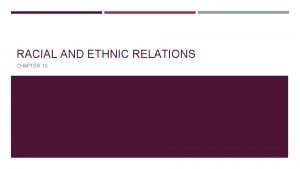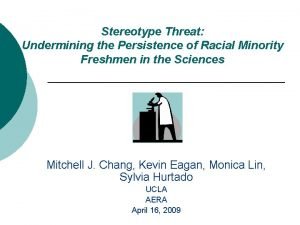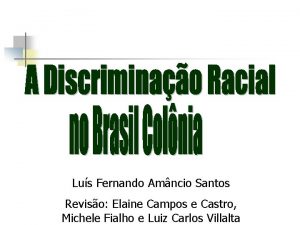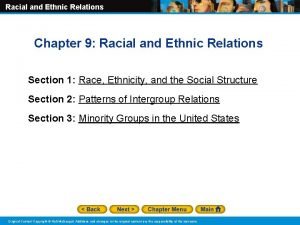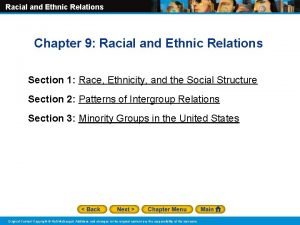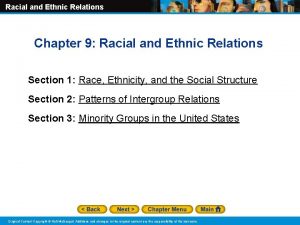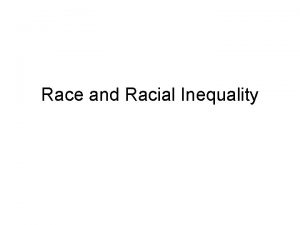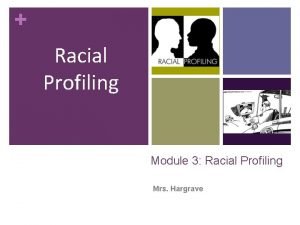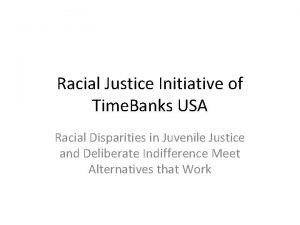Utilizing CDCs AFIX Model in the Racial Ethnic
























- Slides: 24

Utilizing CDC’s AFIX Model in the Racial & Ethnic Adult Disparities in Immunization Initiative (READII) Linda Brown, RN, MEd, CPHQ Mila Verdugo, MPH National Immunization Conference March 22, 2005

Overview • Racial and Ethnic Adult Disparities in Immunization Initiative (READII) • Chicago Plan − Partners − Provider Recruitment • Provider Quality Improvement Project − Process − Clinic Participation − Preliminary Results • Summary • Recommendations

READII • CDC funded demonstration project − September 2002 -December 2004 − Chicago, Milwaukee, San Antonio, Rochester, Mississippi Delta • Improve influenza and pneumococcal immunization coverage among African. American and Hispanic seniors over the age of 65

Chicago Plan • 14 communities identified • Community education − Public Awareness Campaign − Community Outreach • Improve access to immunizations • Encourage use of effective office-based strategies

Partners • African American Health Care Council & Chicago Hispanic Health Coalition − Identify and recruit providers • Chicago Department of Public Health (CDPH) − Identify and recruit providers • VFC provider listing − Conduct ACASAs and feedback sessions − Provide vaccine

Partners • Illinois Foundation for Quality Health Care (IFQHC) − Centers for Medicare and Medicaid Services’ Quality Improvement Organization − In-office and large group education • Utilize existing Quality Improvement Curriculum: Systems To Enhance Preventive Services • Review effective office strategies (standing orders, staff and/or patient reminders, or patient recalls) • Provide resources for implementing strategies

Recruitment Efforts • Initial efforts unsuccessful − Lack of access to free adult vaccine identified as primary barrier to immunization • CDPH intensified recruitment − Letters sent − Phone calls made − Free vaccine offered as incentive

READII Providers, Chicago

Quality Improvement Process • Office-based program modeled after CDC’s AFIX approach: Assessment Feedback Incentive e. Xchange

AFIX Model • Proven success in pediatric settings • Promoted by CDC & American Academy of Pediatrics to increase clinic level immunization coverage

AFIX Model (cont. ) • Recommended by National Vaccine Advisory Committee “Standards of Adult Immunization Practices” − Regular assessments of practice level vaccination rates − Reminder/recall systems for patients and health care professionals − Standing orders for vaccinations

Assessment: Pre-intervention Influenza and Pneumococcal Coverage Levels, ACASA, 2002 N=1342 Charts

Feedback • Office visits conducted with each clinic’s immunization leader − Coverage levels reviewed − Clinic-specific strategies recommended

Incentive • Providers were offered FREE resources for project participation − Influenza & pneumococcal vaccines − Continuing Education Credit − Attendance certificates − Resource Toolkit and Immunization materials (e. g reminder/recall postcards, chart stickers)

e. Xchange • In-office training sessions − Standing Orders − Provider/Patient Reminders • Group Learning Sessions (GLS) to share best practices • Teleconference on Medicare Billing and Reimbursement

Clinic Participation • Of the 31 participating clinics − 31 (100%) had pre-intervention assessments − 23 (74%) received in-office training − 8 (26%) attended 1 st GLS (basic) − 7 (23%) attended 2 nd GLS (advanced) − 8 (26%) attended billing teleconference

Evaluation • Telephone survey conducted to assess − Adoption of recommended strategies − Identify barriers to adoption • ACASA assessments repeated for a sample of provider clinics − Determine clinic-level post-intervention coverage levels

Provider Survey Results August 2004 • System Changes Adopted by Providers, N=29 − − − Standing Orders (11) Flow Sheets (9) Chart Stickers (5) Reminder Calls (2) Reminder Postcards (5) Other (17) i. e. walk-in clinic hours, new chart dividers, posters in patient & waiting rooms, pre-appt. chart review, TOTS registry

Provider Survey Results • CDC, CDPH or IFQHC resources used by providers − Vaccine Information Statements (20) − Flow Sheets (4) − Chart Stickers (8) − Posters, Brochures, IZ Cards (26)

Provider Survey Results • Did your clinic administer more vaccine this past flu season with the additional supply of free vaccine? − 26/29 (90%) responded “YES” • Were they patients who wouldn’t normally have received vaccine? − 25/26 (96%) responded “YES”

Post-intervention Influenza and Pneumococcal Coverage levels, ACASA, 2002 vs. 2003 % N=327 Charts

Summary • Providers who participated in the AFIX activities were likely to adopt recommended immunization strategies • Clinic-level immunization coverage rates increased from 2002 to 2003 • Combining CDC’s AFIX approach with the state QIO’s curriculum was an efficient and effective method for educating providers

Recommendations • Post-intervention (2004) coverage levels should be determined in READII clinics to determine the impact of the combined approach on immunization coverage levels • CDPH and the QIO should continue to support the clinics in order to encourage continued use of effective strategies

Contact Information For further questions, please contact: Linda Brown, RN, MEd, CPHQ Illinois Foundation for Quality Health Care Lbrown@ilqio. sdps. org 800 -386 -6431, #5815 Mila Verdugo, MPH Chicago Department of Public Health Verdugo_Mila@cdph. org 312 -746 -5381
 Cdc afix
Cdc afix Chapter 10 racial and ethnic relations review worksheet
Chapter 10 racial and ethnic relations review worksheet Chapter 10 racial and ethnic relations
Chapter 10 racial and ethnic relations Chapter 10 racial and ethnic relations review worksheet
Chapter 10 racial and ethnic relations review worksheet Tuning out dull topics
Tuning out dull topics Thud drill football
Thud drill football Cultural identity development models
Cultural identity development models Jim crow laws in what region or regions did it exist
Jim crow laws in what region or regions did it exist Black studies and the racial mountain
Black studies and the racial mountain Racial wealth gap simulation
Racial wealth gap simulation Promoting racial literacy in schools
Promoting racial literacy in schools William jennings bryan apush
William jennings bryan apush Racial prejudice
Racial prejudice Don tiburcio de españa
Don tiburcio de españa Racial insults
Racial insults In what regions did the literacy test exist
In what regions did the literacy test exist Cartel ley organica contra la discriminacion racial
Cartel ley organica contra la discriminacion racial Democracia racial
Democracia racial Lesson 2: racial discrimination
Lesson 2: racial discrimination Hát kết hợp bộ gõ cơ thể
Hát kết hợp bộ gõ cơ thể Frameset trong html5
Frameset trong html5 Bổ thể
Bổ thể Tỉ lệ cơ thể trẻ em
Tỉ lệ cơ thể trẻ em Voi kéo gỗ như thế nào
Voi kéo gỗ như thế nào Tư thế worm breton
Tư thế worm breton

